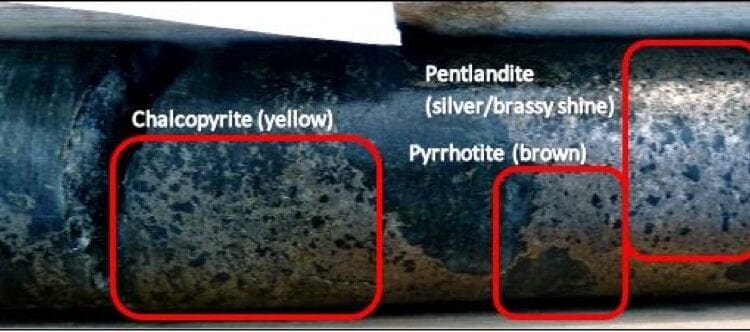Massive Sulphide Mineralisation Intersected At Tullsta
Ragnar Metals Limited (ASX: RAG) has intersected significant magmatic sulphide mineralisation in the second drill hole of the maiden drilling programme at its 100%-owned Tullsta Nickel Project in Sweden.
Visual inspection of core from diamond drill hole 21DDTS002 by supervising Swedish geologists GeoVista AB in Sweden and a review of the core photos/logs by the company’s Australian geologist from Geolithic Geological Services in Australia confirms the collective opinion that the mineralisation contains primary Ni- Cu bearing sulphides of magmatic origin
Ragnar has dispatched the core for assaying to confirm the presence and grade of nickel-copper-PGE mineralisation and expects results during the September quarter.
Ragnar’s consulting geologist, Neil Hutchison, said the visual inspection of the sulphide mineralisation and the intrusive host rocks at Granmuren, remarkably have a very similar rock type, mineral composition, intrusive textures, sulphide style and metal abundance as the Carr Boyd and Andover magmatic nickel-copper sulphide discoveries (in Western Australia) that Geolithic was involved in during 2020-2021.
“These Projects are still successfully drilling and continuing to expand the known mineralisation,” Mr Hutchison said.
“Even without the confirmation of assay or pXRF data at this early stage, it is obvious that these sulphides contain copper as evident by the chalcopyrite mineralisation, and the core photos display abundant silver/brassy metallic sulphide crystals within the pyrrhotite, which are consistent with Ni-bearing pentlandite mineralisation.
“It would be reasonable to expect that Granmuren would also deliver more sulphide mineralisation and similar Ni-Cu grades, given they are all the same style of mineralisation from magmatic intrusive origin, even though Granmuren is on the other side of the globe.”
The company first discovered near surface Ni-Cu-Co mineralisation at Tullsta from heliborne VTEM survey data in 2012. In 2018, Geolithic and GeoVista commenced re-evaluation and field work on the Granmuren mineralisation, recognising the sulphides had been remobilised from a distal source.
Chairman, Steve Formica, sai Ragnar commissioned GeoVista to complete an IP-Resistivity survey over the area in late 2019, and 3D modelling of the data defined a large NW plunging anomaly below the Granmuren mineralisation. The geological and geophysical model was similar to the Sakatti Ni-Cu-PGE deposit to the NE across the border in Finland, which was discovered in 2009.
The 3D IP model defined a continuous body that extends from below the level of historical drilling and open to the northwest. Magnetic and gravity modelling also indicated a western to north-western plunging body trending towards the Tullsta Nr8 permit area, which abuts the Berga Nr1 permit. Ragnar planned four drill holes to target this modelled body, and has completed two to date, with the third hole underway.
“I am extremely pleased with hitting significant broad sulphide mineralisation zones in only our second drill hole of our maiden programme at Tullsta. These drill targets were generated in 2018 but we have had to exercise patience whilst waiting for Ragnar to be financially able to explore a potentially game-changing target,” Mr Formica said.
“The delay may be a blessing in disguise as I feel that timing is now on our side. The impending electric vehicle demand gives Ragnar the opportunity to be in the right commodity in the right place in the heart of European battery manufacturers. I look forward to working with our technical experts at GeoVista and Geolithic in progressing our discovery at Tullsta.”
For further information please visit: https://www.ragnarmetals.com.au/












